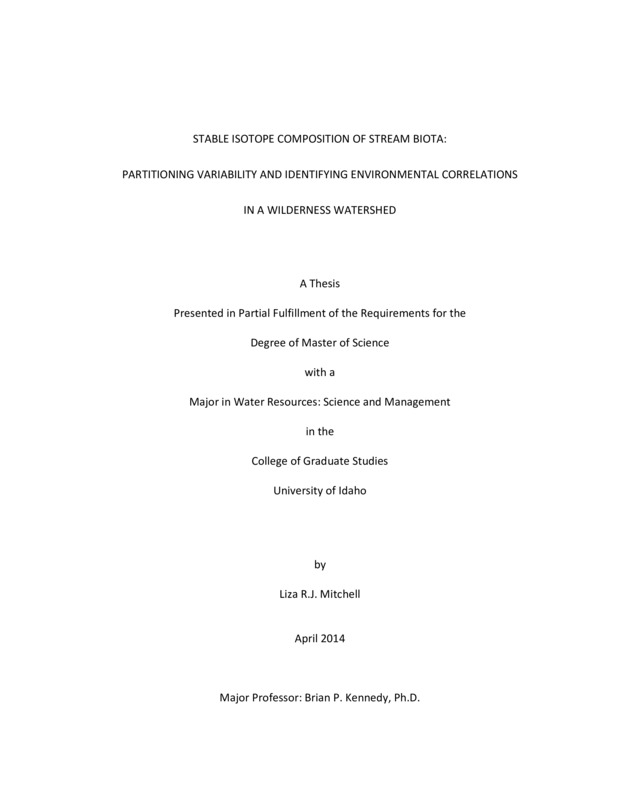STABLE ISOTOPE COMPOSITION OF STREAM BIOTA: PARTITIONING VARIABILITY AND IDENTIFYING ENVIRONMENTAL CORRELATIONS IN A WILDERNESS WATERSHED
Mitchell, Liza R. (2014). STABLE ISOTOPE COMPOSITION OF STREAM BIOTA: PARTITIONING VARIABILITY AND IDENTIFYING ENVIRONMENTAL CORRELATIONS IN A WILDERNESS WATERSHED. Theses and Dissertations Collection, University of Idaho Library Digital Collections. https://www.lib.uidaho.edu/digital/etd/items/mitchell_idaho_0089m_10204.html
- Title:
- STABLE ISOTOPE COMPOSITION OF STREAM BIOTA: PARTITIONING VARIABILITY AND IDENTIFYING ENVIRONMENTAL CORRELATIONS IN A WILDERNESS WATERSHED
- Author:
- Mitchell, Liza R
- Date:
- 2014
- Keywords:
- Idaho nitrogen stable isotopes sulfur wilderness
- Program:
- Water Resources
- Subject Category:
- Ecology; Biogeochemistry
- Abstract:
-
Stable isotopes are used frequently in biogeochemistry and ecology to identify the use and movement of material within ecosystems and around the world. The isotopic composition of organic matter changes in predictable ways and often those changes are preserved as the elements cycle through space, time and trophic levels. Analysis of carbon, nitrogen and sulfur stable isotopes has become a common tool in aquatic stream ecology to help reveal the complex interactions and processes that occur beneath the water in these dynamic systems. In this thesis, I explore patterns of stable isotope composition of periphyton and macroinvertebrates in a wilderness stream network and investigate correlations to natural environmental heterogeneity. Chapter 1 explores the spatial and temporal variability in nitrogen, carbon and sulfur stable isotope values of aquatic biota, observed trophic discrimination, and correlations with environmental landscape characteristics. I found that the nitrogen, carbon and sulfur isotopic composition of periphyton and macroinvertebrates does vary considerably in this watershed and that this variability can be parceled out and attributed to a few major factors, specifically species and site. Correlations with wildfire and geology appear to be more important parameters in predicting nitrogen and sulfur stable isotopes, respectively, than spawning salmon in this watershed. In Chapter 2, I utilize creative nonfiction narratives to inform non-scientific audiences on stream ecology, stable isotopes and cross-ecosystem subsidies, fostering holistic ecosystem thinking and attention to waterways as multi-directional corridors. This interdisciplinary approach to scientific research and communication effectively conveys a message to readers, educating them on stable isotope ecology, its utility in measuring connectivity of disparate ecosystems, and how understanding variability and environmental heterogeneity promises to help us in the future.
- Description:
- masters, M.S., Water Resources -- University of Idaho - College of Graduate Studies, 2014
- Major Professor:
- Kennedy, Brian P
- Committee:
- Fremier, Alex K; Evans, R D; Slovic, Scott
- Defense Date:
- 2014
- Identifier:
- Mitchell_idaho_0089M_10204
- Type:
- Text
- Format Original:
- Format:
- application/pdf
- Rights:
- In Copyright - Educational Use Permitted. For more information, please contact University of Idaho Library Special Collections and Archives Department at libspec@uidaho.edu.
- Standardized Rights:
- http://rightsstatements.org/vocab/InC-EDU/1.0/

